In today’s competitive world, one needs more than just excellent services to stand out as a dental practice; one needs smart marketing.
You might be a great dentist and perhaps depend on word-of-mouth or traditional ways to bring in patients, but will that do in this digital world?
The answer lies in using online platforms, such as Google Ads, which show your services to potential patients right when they need them.
Whether you’re new to digital advertising or looking to refine your strategy, this guide will help you understand how Google Ads can transform your practice.
- Understanding the Role of Google Ads in Dental Marketing
- Setting Up Effective Google Ads Campaigns for Dentists
- Optimizing Google Ads Performance for Dental Practices
- Measuring the Success of Your Dental Practice’s Google Ads Campaigns
- Integrating Google Ads with Other Digital Marketing Strategies for Dental Practices
- Maximizing Success with Google Ads for Dentists
- Frequently Asked Questions About Google Ads for Dentists
Understanding the Role of Google Ads in Dental Marketing
Google Ads is a powerful tool for promoting dental practices in today’s highly digitalized world.
With millions of people searching for local dentists every month, having your practice appear at the top of search results is invaluable.
But what exactly makes Google Ads essential for dentists?
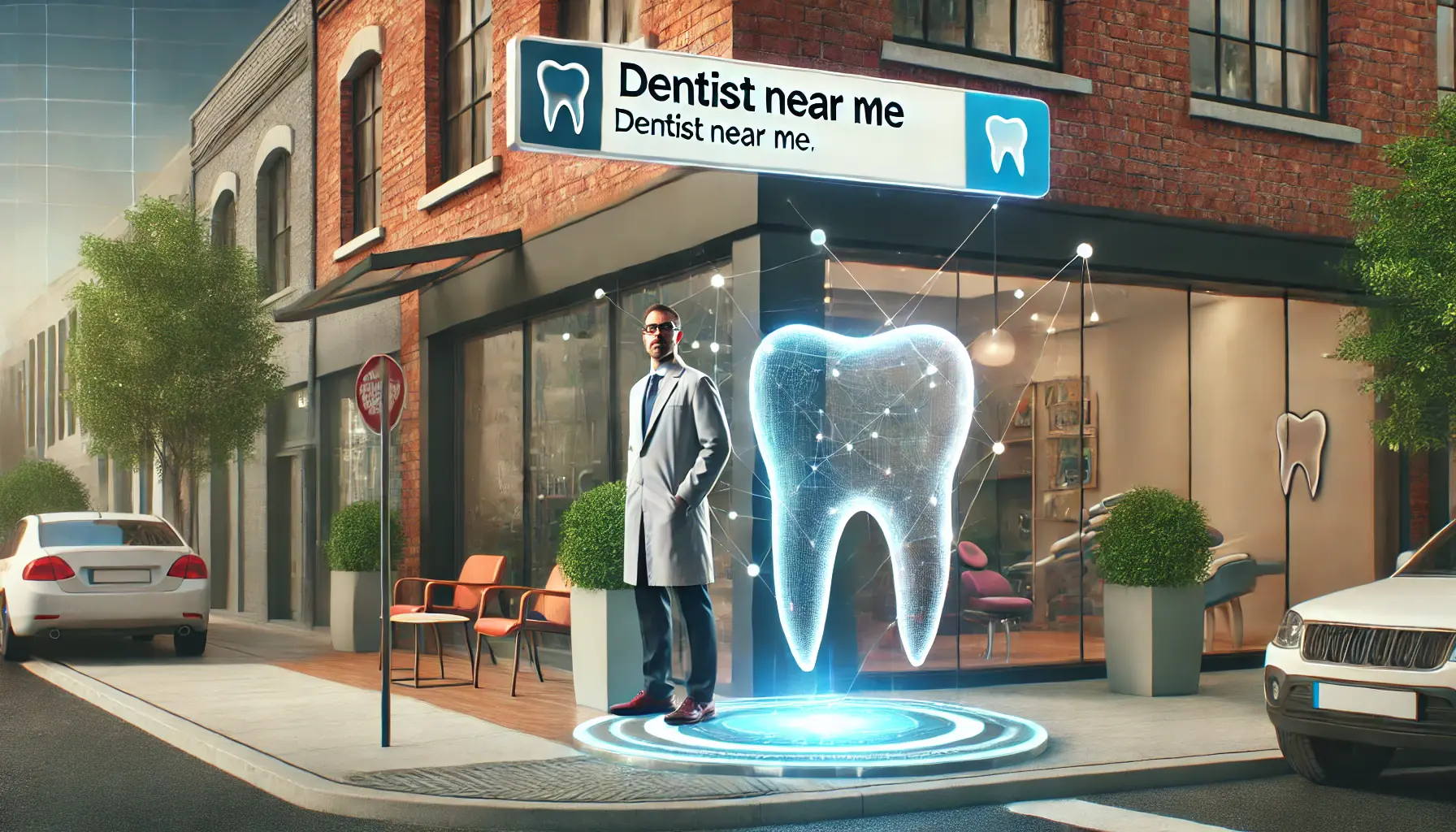
A professional dental clinic showcasing its presence in the community and importance of being found online.
The Importance of Online Visibility for Dental Practices
Imagine a patient in your area searching for a “dentist near me” or “emergency dental services.” If your practice isn’t visible on the first page of search results, you’re likely missing out on valuable leads.
Google Ads ensures that your practice not only appears in these searches but also stands out to potential patients.
Online visibility builds trust and credibility.
When patients see your ad at the top, they perceive your practice as reliable and professional.
This is especially critical for dental services, where trust plays a significant role in a patient’s decision-making process.
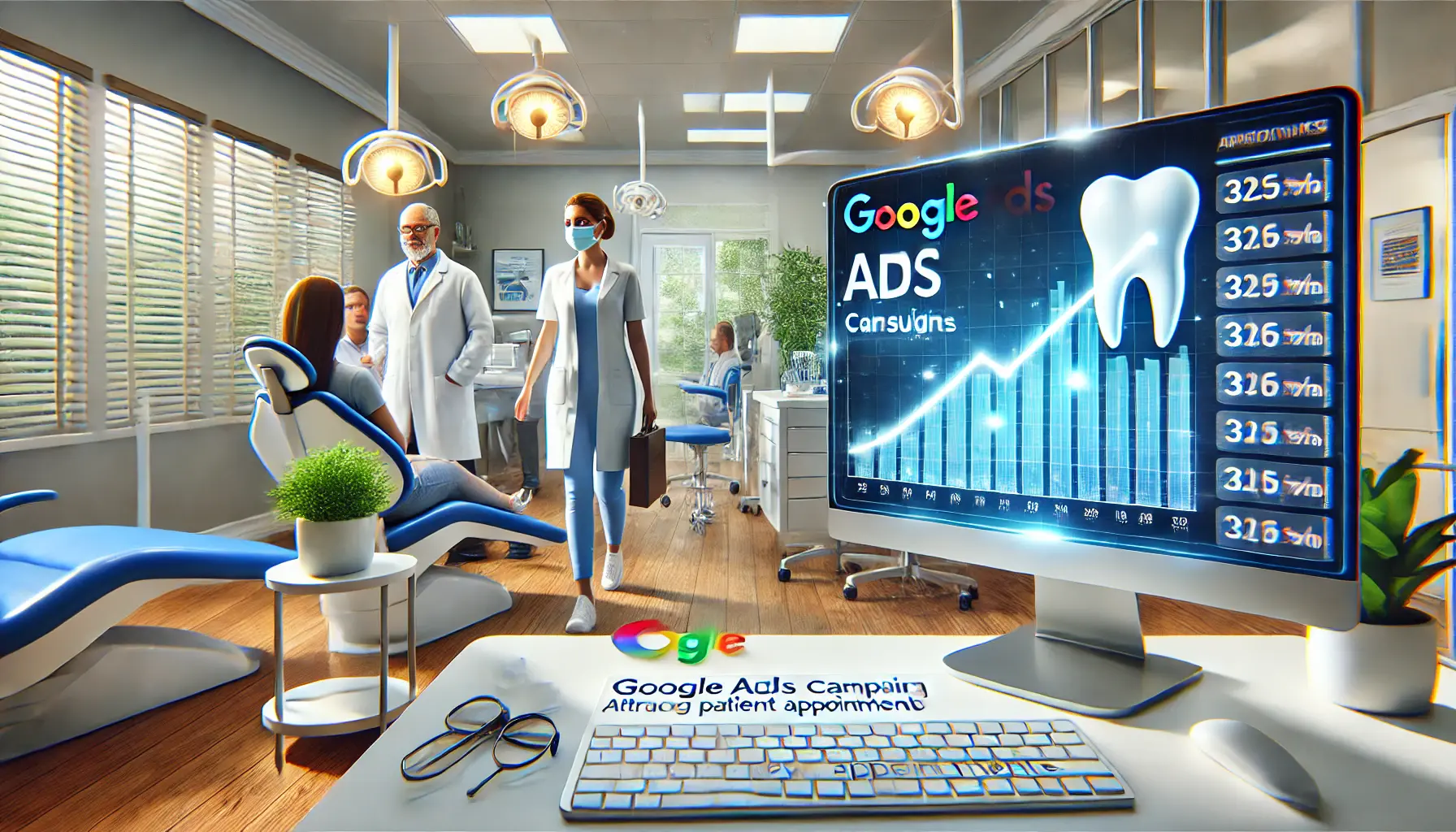
A dental clinic showcasing the impact of Google Ads in driving new patient appointments.
How Google Ads Can Attract New Patients
Google Ads is based on a pay-per-clickAn online advertising model where advertisers pay each time a user clicks on their ad. advertising model, which means you only pay when someone clicks on your ad.
This allows every dollar spent to be focused on potential patients who are actively seeking dental services.
You can also target specific keywords such as “teeth cleaning,” “cosmetic dentistry,” or “dental implants” to find patients who need just what you provide.
- Immediate Results: Unlike organic SEO, Google Ads generates results as soon as your campaign is live.
- Localized Targeting: You can focus your ads on specific areas to attract patients near your practice.
- Customized Messaging: Tailor your ads to highlight your unique services, promotions, or expertise.
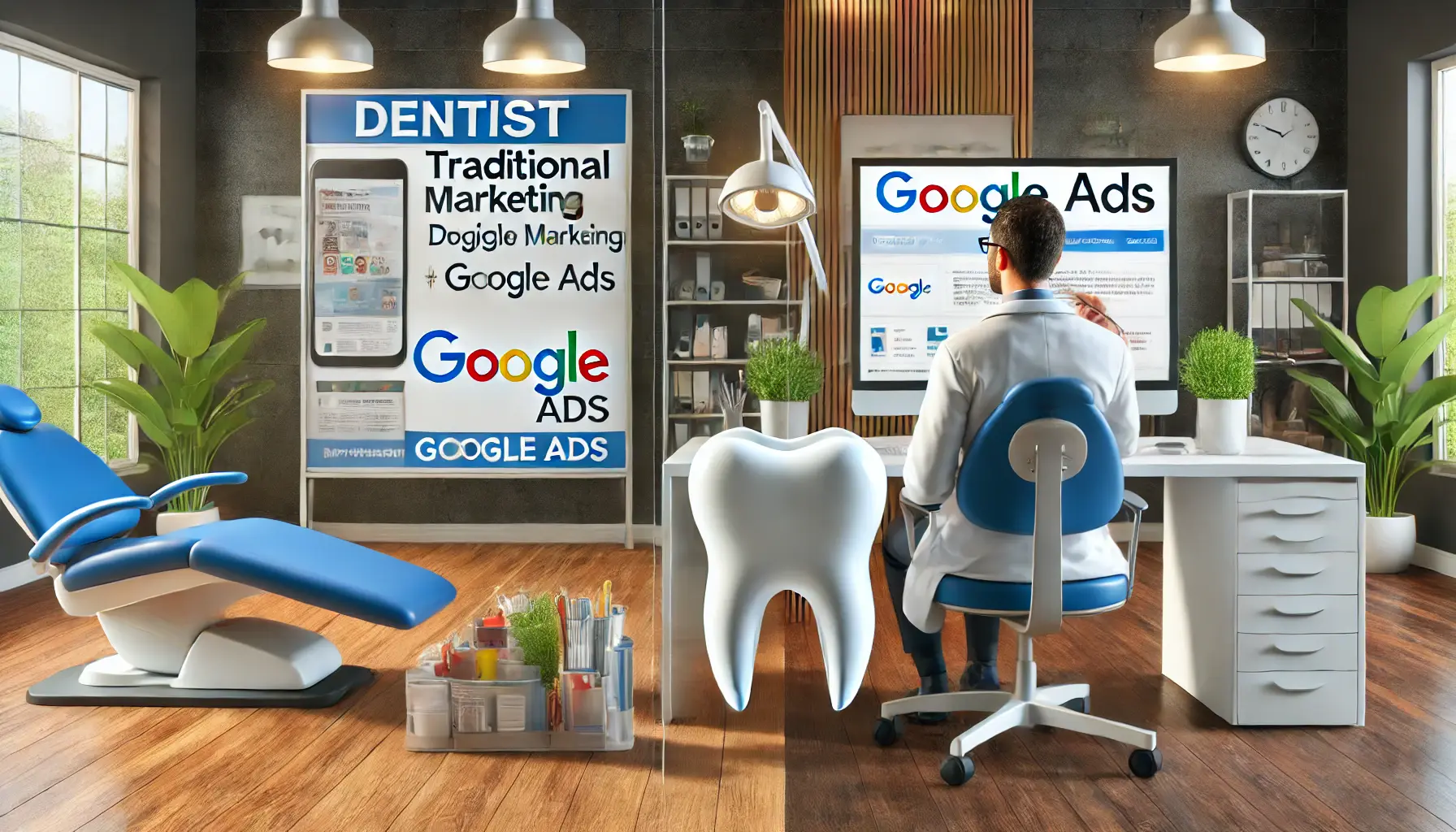
A dental professional comparing traditional and digital marketing methods to evaluate their effectiveness.
Comparing Google Ads to Traditional Marketing Methods
While traditional marketing methods like flyers, radio ads, and billboards have their merits, they lack the precision and measurability of Google Ads.
With Google Ads, you can track every click, impression, and conversion to understand what works best for your practice.
- Cost Efficiency: Google Ads ensures your budget is spent on qualified leads, unlike broad campaigns in traditional media.
- Real-Time Adjustments: Modify your campaigns anytime based on performance metrics, something impossible with printed materials.
- Better Reach: Reach patients actively searching for dental services, as opposed to passive audiences in traditional channels.
In essence, Google Ads provides a modern, effective approach to growing your practice.
By investing in targeted online advertising, you’re positioning your dental practice for long-term success in an increasingly digital world.
Google Ads ensures local patients find your dental practice when searching online, building credibility and driving appointments effectively.

A dentist preparing a Google Ads campaign to attract new patients in a professional and modern dental office.
Setting Up Effective Google Ads Campaigns for Dentists
The Google Ads campaign is going to bring in a lot of visibility for a dental practice and attract new patients.
But it has to be set up with much thought and strategy in order to get the most out of it.
Let’s consider the main steps to make your Google Ads efforts effective and productive.

A dentist focused on keyword research for dental services to improve digital marketing strategies.
Conducting Keyword Research for Dental Services
The first step in a Google Ads campaign is to identify the right keywords.
Start by brainstorming the terms potential patients might use to search for dental services.
Identify these by using tools such as Google Keyword PlannerA free tool by Google that helps advertisers find relevant keywords and analyze their search volume., which will help find relevant keywords with the appropriate search volume.
- Focus on Specific Services: Include keywords for specific treatments that you provide, such as “teeth whitening,” “dental implants,” or “emergency dentist.” This way, you attract patients who are looking for those specific services.
- Include Local Keywords: Add your city or neighborhood to your keywords, such as “Mersin dentist” or “dental clinic in Mersin,” to attract local search traffic.
- Utilize Long-Tail Keywords: Phrases like “affordable family dentist in Mersin” may have lower search volumes but often lead to higher conversion rates due to their specificity.

A dentist working on creating compelling ad copy for a digital campaign aimed at attracting new patients.
Creating Compelling Ad Copy to Engage Potential Patients
Your ad copy should be clear, concise, and directly address the needs of potential patients.
Highlight unique aspects of your practice and include a strong call-to-action (CTA).
- Emphasize Unique Selling Points: Mention what sets your practice apart, such as “state-of-the-art equipment” or “over 20 years of experience.”
- Include Promotions or Offers: Attract attention with special deals like “Free initial consultation” or “20% off teeth cleaning for new patients.”
- Use Action-Oriented Language: Encourage immediate action with CTAs like “Book your appointment today” or “Call now to schedule.”

A dentist configuring ad extensions to enhance the visibility of an online ad campaign in a professional office setting.
Utilizing Ad Extensions to Enhance Visibility
Ad extensions are a source of additional information and make your ad more attractive to potential clients.
They can include links to specific web pages of your website, your address, telephone number, or customer reviews.
Each one has its own purpose:
- Sitelink Extensions: These link users directly to specific pages such as “Our Services” or “Patient Testimonials.”
- Call Extensions: This lets users call your practice right from the ad. Particularly useful for mobile users.
- Location Extensions: Display your practice’s address and a map, helping local patients find you easily.

A dentist using geo-targeting tools to optimize their Google Ads campaign for reaching local patients.
Implementing Geo-Targeting to Reach Local Audiences
As a dental practice, your primary audience is local.
Geo-targeting ensures your ads are shown to users within a specific geographic area, maximizing relevance and cost-effectiveness.
- Set Location Parameters: In your campaign settings, define the radius around your practice where you want your ads to appear.
- Exclude Irrelevant Areas: Keep your ads from showing up in areas you do not serve to avoid unnecessary clicks and expenses.
- Adjust Bids Based on Location: Increase bids for areas closer to your practice, as it is closer proximity for a patient to come visit you.
By setting up your Google Ads campaigns correctly with these strategies, you’ll have a much better chance of engaging potential patients and growing your dental practice through more appointments.
Thoughtful setup, including proper keyword research and compelling ad copy, is crucial to maximizing the impact of your Google Ads campaigns.

A dentist analyzing performance data and optimizing their Google Ads campaign to improve patient acquisition.
Optimizing Google Ads Performance for Dental Practices
Once your Google Ads campaign is up and running, the next crucial step is optimization.
Continuous monitoring and refining of your ads ensure that your dental practice maximizes return on investment (ROI) and effectively attracts new patients.
Let’s delve into key strategies to enhance your Google Ads performance.

A dentist reviewing KPIs like click-through rate and conversion rate to optimize their Google Ads campaign performance.
Monitoring Key Performance Indicators (KPIs) in Google Ads
Keeping track of KPIs helps you monitor the effectiveness of your campaigns and make informed decisions.
The following are essential KPIs for dental practices:
- Click-Through Rate (CTR): The percentage of users who click on your ad after seeing it. A higher CTR indicates that your ad is relevant and engaging.
- Conversion Rate: The rate at which clicks result in a desired action, such as booking an appointment. This reflects the effectiveness of your landing page and overall campaign.
- Cost Per Click (CPC): The average amount you pay for each click. Monitoring CPC helps in managing your budget and ensures cost-effectiveness.
- Cost Per Conversion: The cost incurred for each conversion. Keeping this metric low is vital for a profitable campaign.
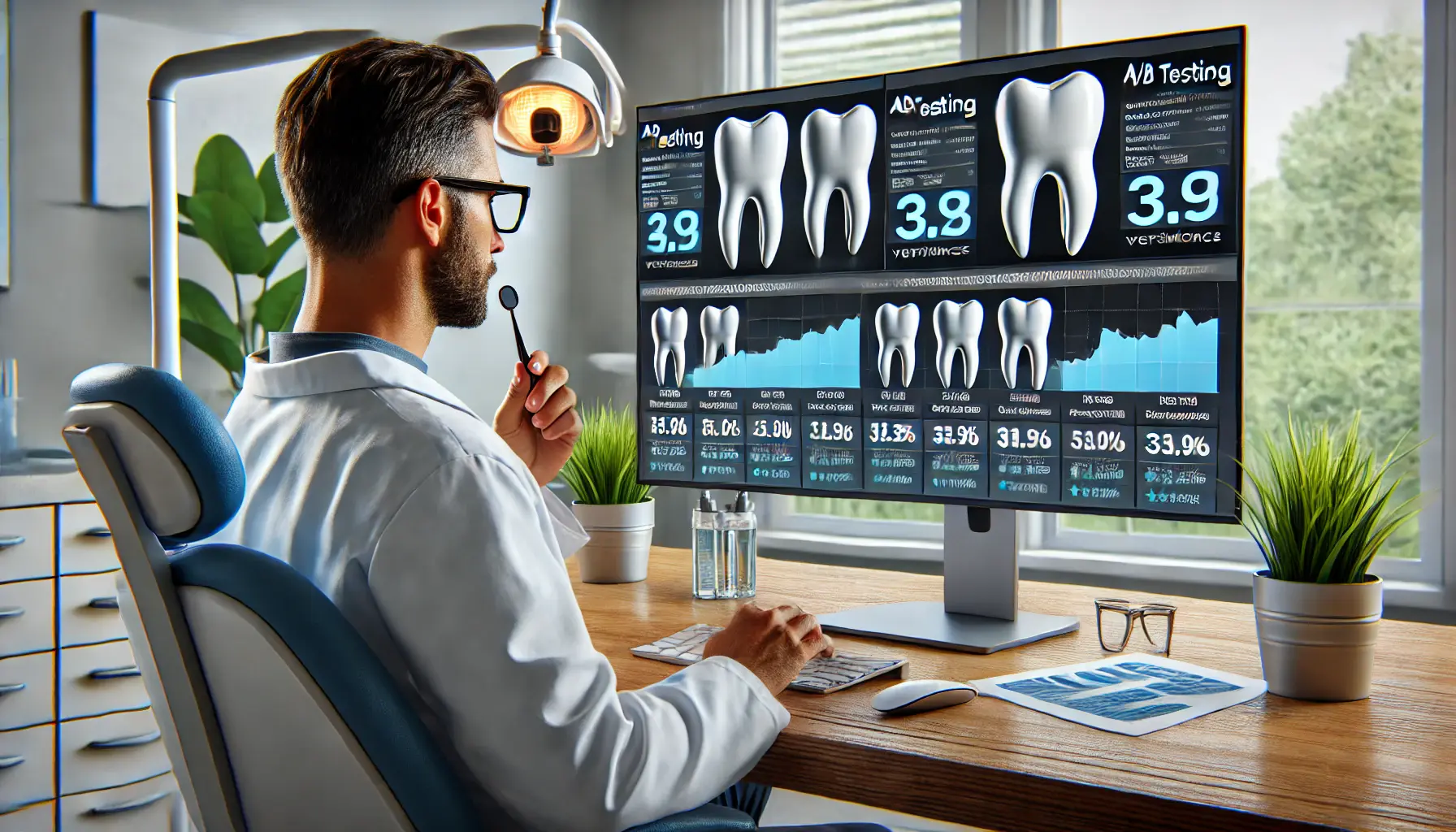
A dentist analyzing the performance of different ad variations through A/B testing to improve campaign results.
A/B Testing Ad Variations to Improve Click-Through Rates
A/B testing involves creating multiple versions of your ads to determine which performs better.
By experimenting with different headlines, descriptions, and calls-to-action, you can identify the most effective combinations.
For example, testing variations like “Book Your Appointment Today” versus “Schedule Your Visit Now” can reveal which phrasing resonates more with your audience.

A dentist analyzing different bidding strategies, such as manual CPC and enhanced CPC, to optimize a cost-effective Google Ads campaign.
Adjusting Bidding Strategies for Cost-Effective Campaigns
The right bidding strategy will help you control costs and achieve maximum ad exposure.
Consider the following approaches:
- Manual CPC Bidding: Allows you to set maximum bid amounts for every keyword, giving you complete control over your spending.
- Enhanced CPC: Automatically adjusts your manual bids for maximum conversions using Google’s machine learning algorithms.
- Target CPA (Cost Per Acquisition): Sets bids to help get as many conversions as possible at the target cost per action you set.
Regularly reviewing and adjusting your bids based on performance data ensures that you are not overspending on underperforming keywords.

A dentist optimizing a Google Ads campaign by leveraging negative keywords to refine audience targeting.
Leveraging Negative Keywords to Refine Audience Targeting
Negative keywords prevent your ad from showing up for irrelevant searches, saving budget while improving ad relevance.
For example, if you do not offer orthodontic services, adding “braces” as a negative keyword will prevent your ad from appearing in such searches.
Regularly updating your negative keyword list based on search term reports is important for refining your audience targeting.
By implementing these optimization strategies, your dental practice can make your Google Ads much more effective, resulting in more patients and a better return on investment.
Regular optimization and tracking of KPIs like CTRClick-Through Rate, the percentage of users who click on an ad after viewing it. and CPACost Per Acquisition, the cost associated with acquiring a new customer through an ad. ensure your Google Ads campaigns remain efficient and effective.
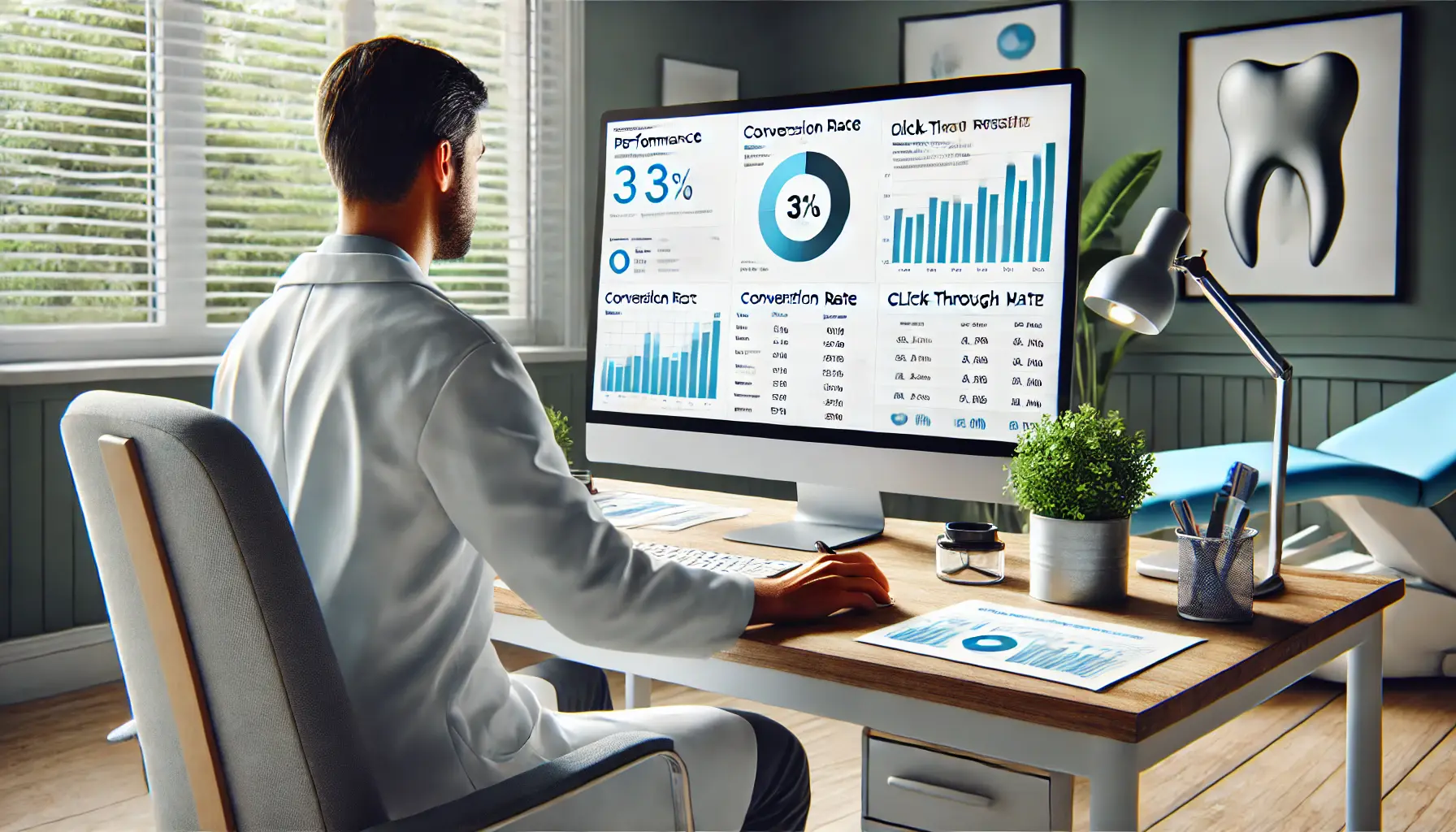
A dentist evaluating the success of their Google Ads campaign by analyzing performance metrics and key data.
Measuring the Success of Your Dental Practice’s Google Ads Campaigns
After implementing and optimizing your Google Ads campaigns, it’s essential to assess their effectiveness.
Measuring success not only validates your efforts but also provides insights for future improvements.
Let’s explore the key metrics and strategies to evaluate your dental practice’s Google Ads performance.
A dentist analyzing conversion tracking data to optimize their Google Ads campaign performance.
Analyzing Conversion Tracking Data
Conversion tracking helps you determine how your ads are leading to valuable patient actions, such as appointment bookings or contact form submissions.
By setting up conversion trackingA method to measure the actions users take after interacting with your ad, such as form submissions or purchases. in Google Ads, you can:
- Identify High-Performing Keywords: Learn which keywords drive more conversions so you can more effectively distribute your budget.
- Analyze Ad Copy Effectiveness: Identify which ad versions deliver higher conversion rates and use this input to inform future ad copy decisions.
- Track ROI: Understand the revenue your ads generate compared to their cost to ensure your campaigns are profitable.

A dentist analyzing CTR and quality scores to optimize the performance of a Google Ads campaign.
Evaluating Click-Through Rates (CTR) and Quality Scores
CTR is the percentage of users who, after seeing your ad, actually click on it.
A higher CTR reflects relevance and appeal.
Generally, a higher CTR leads to an improved Quality ScoreGoogle's measure of the relevance and quality of your ads, keywords, and landing pages., which is Google’s method for assessing the quality and relevance of your ads and keywords.
A high Quality Score may result in:
- Lower Cost Per Click (CPC): Higher Quality Scores can reduce the amount you pay per click, stretching your budget further.
- Improved Ad Positioning: Quality Scores influence ad placement on search results pages; the higher the score, the better and more prominent the positioning.
By regularly monitoring and optimizing for CTR and Quality Scores, you can improve the overall performance of your campaign.
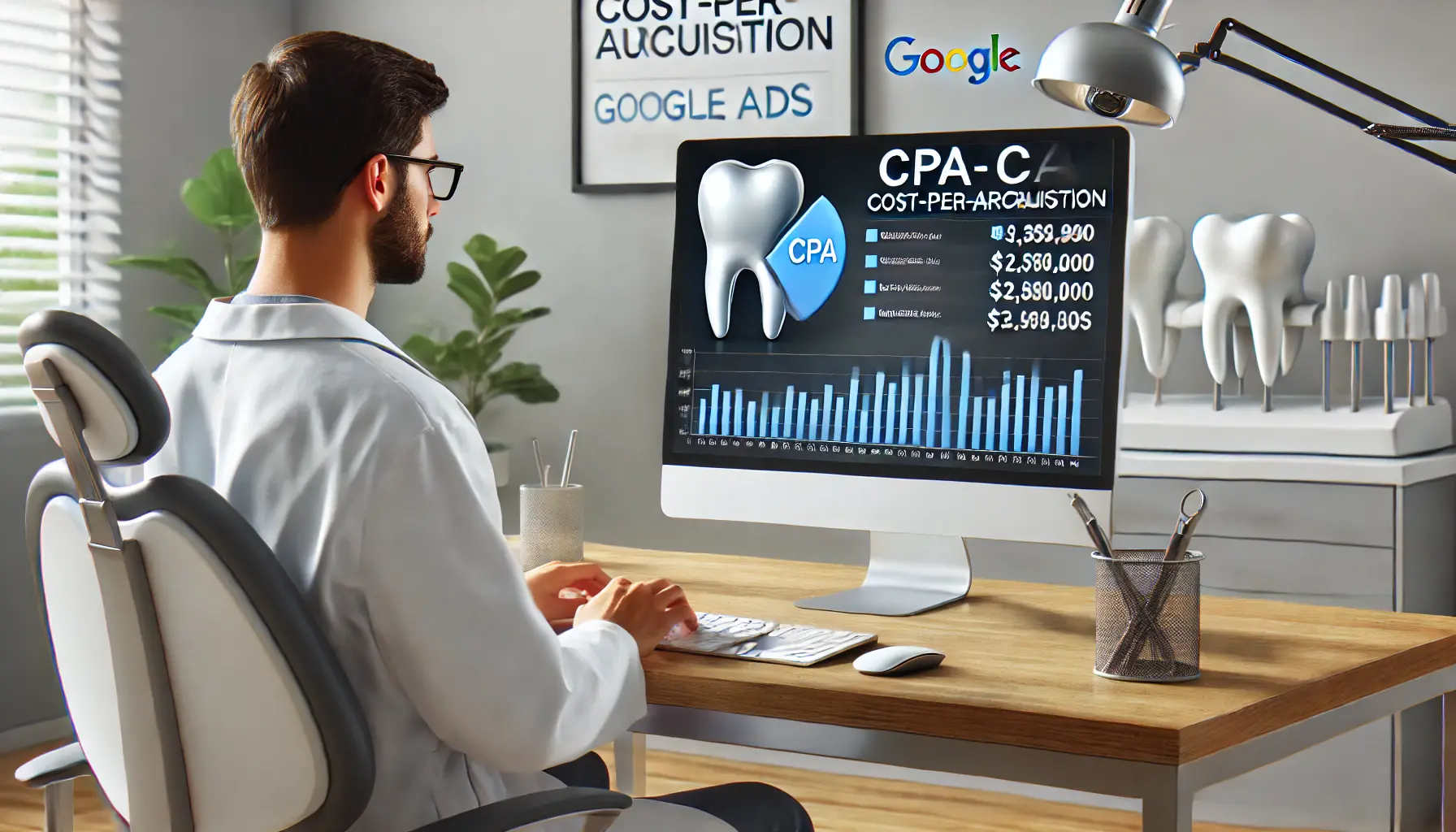
A dentist reviewing CPA data to assess the cost-effectiveness of acquiring new patients through Google Ads.
Assessing Cost Per Acquisition (CPA)
CPA refers to the average cost of acquiring a new patient through your ads.
To maintain a profitable campaign, CPA should remain as low as possible.
For proper CPA management:
- Optimize Targeting: Ensure your targeting reaches only users most likely to convert.
- Enhance Landing Pages: Make sure landing pages are user-friendly and optimized for conversions.
- Adjust Bidding Strategies: Apply bidding strategies that match your desired CPA, like Target CPA bidding.
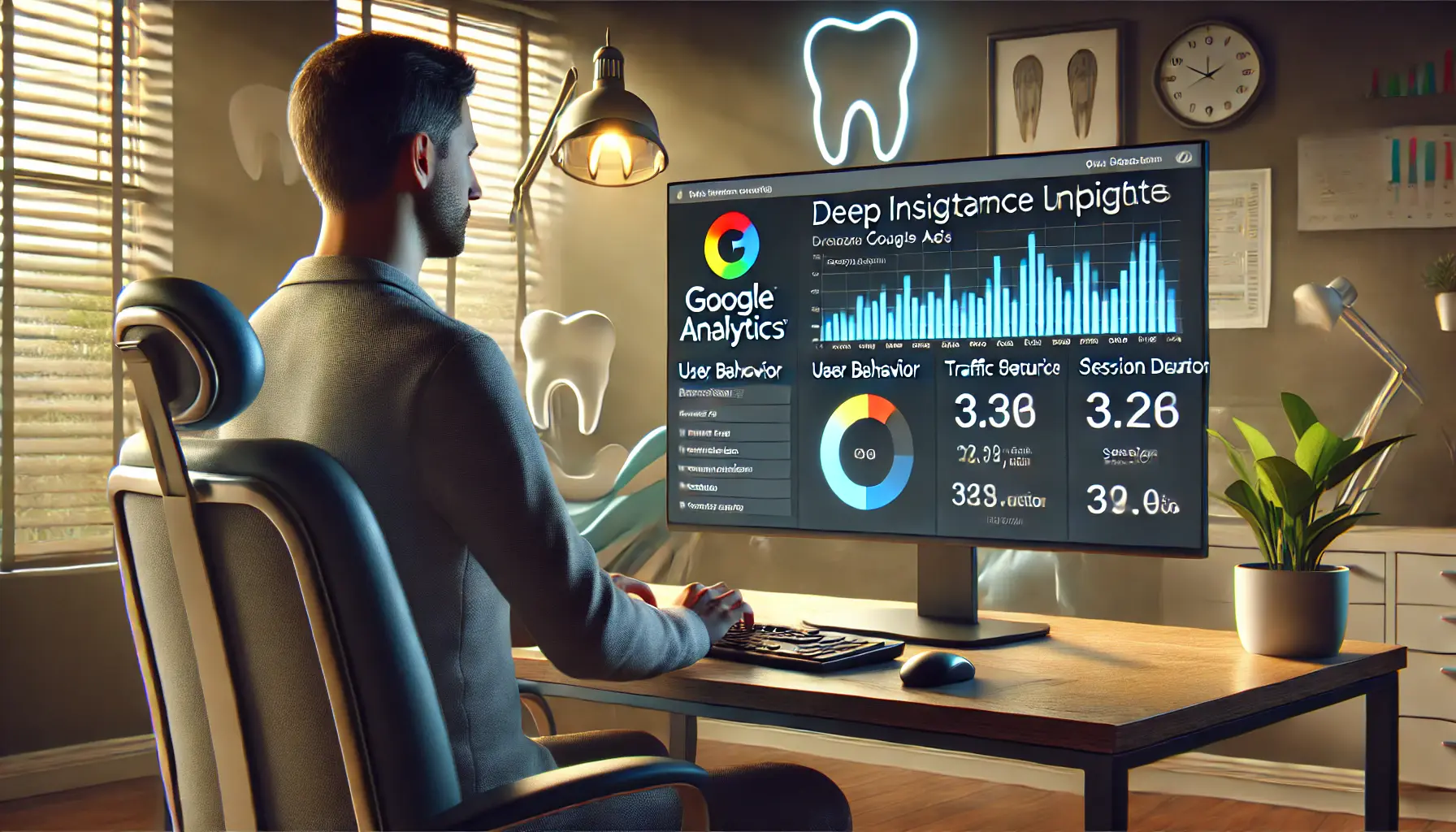
A dentist reviewing Google Analytics data to gain deep insights for optimizing Google Ads campaigns.
Leverage Google Analytics for Deep Insights
Linking your Google AnalyticsA tool by Google that tracks and reports website traffic and user behavior. account with Google Ads provides a detailed understanding of user behavior on your website.
This integration enables you to:
- Track User Journeys: Understand the paths users take on your site after clicking an ad, identifying potential drop-off points.
- Measure Engagement Metrics: Analyze metrics such as average session duration and pages per session to gauge user interest.
- Identify Conversion Paths: Discover the steps users take before converting to streamline the process and encourage more conversions.
By utilizing these various measurement tools and strategies, your dental practice will gain valuable insights into the performance of your Google Ads campaign, enabling data-driven decisions to improve patient acquisition and overall marketing success.
Analyze conversion tracking data and assess Quality Scores to refine strategies and maximize the ROI of your Google Ads campaigns.

A dentist analyzing the integration of Google Ads with other digital marketing strategies to optimize the dental practice’s online presence.
Integrating Google Ads with Other Digital Marketing Strategies for Dental Practices
To maximize the effectiveness of your dental practice’s online presence, it’s essential to integrate Google Ads with other digital marketing strategies.
This holistic approach ensures a cohesive brand message and enhances patient engagement.
Let’s explore how combining Google Ads with various digital marketing channels can benefit your practice.
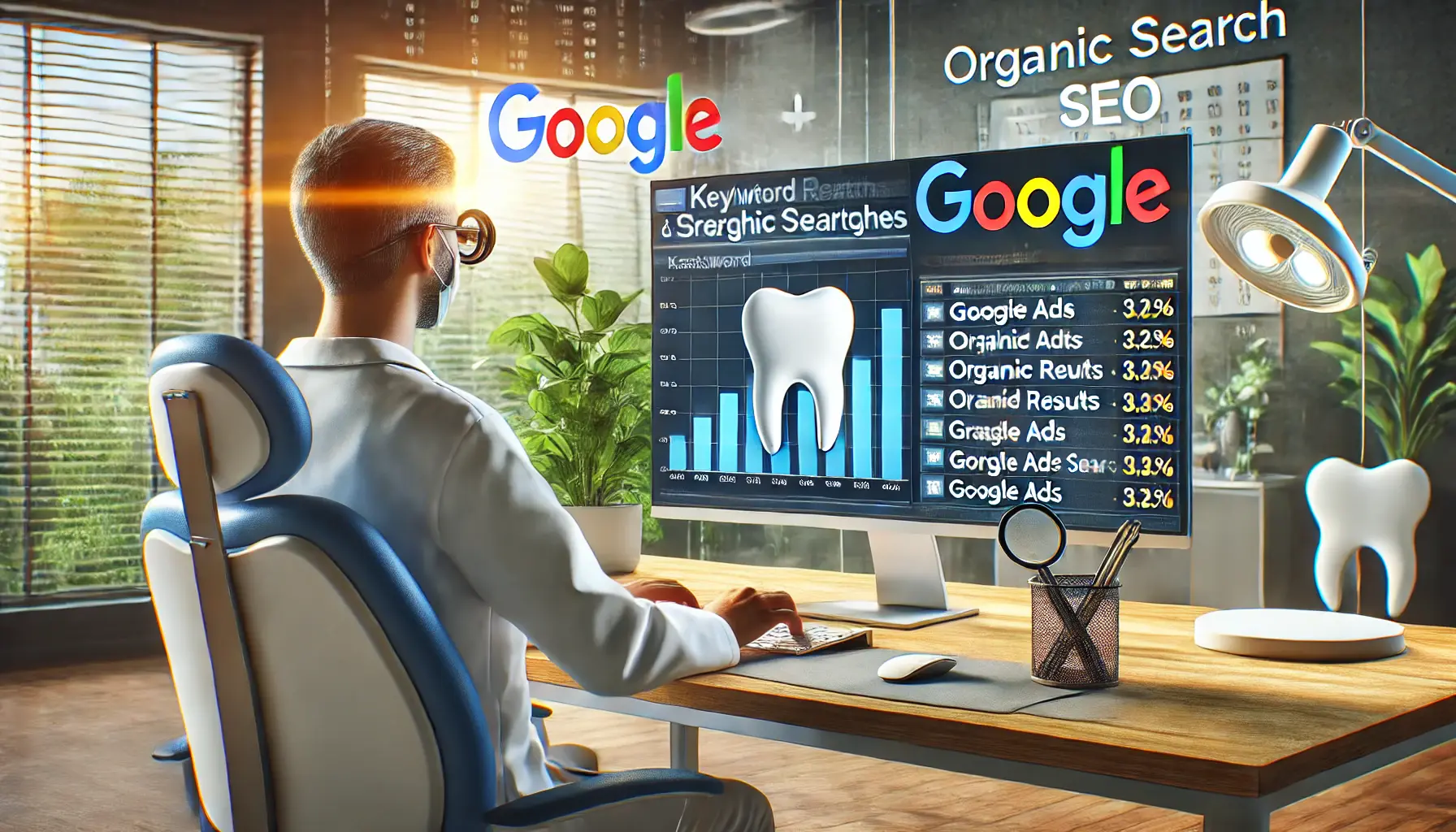
A dentist analyzing both Google Ads and SEO performance data to combine paid and organic search strategies.
Combining Google Ads with Search Engine Optimization (SEO)
While Google Ads immediately provide visibility, SEOSearch Engine Optimization, the practice of improving a website's visibility in organic search results. focuses on organic search rankings for long-term results.
By aligning paid and organic strategies, you can:
- Dominate Search Results: Appear in both paid ads and organic listings to increase visibility and credibility for your practice.
- Inform Keyword Strategy: Use data from Google Ads to identify high-performing keywords and target them in your SEO work.
- Improve User Experience: Consistent messaging between ads and organic content builds trust and credibility with users.

A dentist reviewing social media marketing performance and Google Ads data to combine both strategies effectively.
Leverage Social Media Marketing in Conjunction with Google Ads
Social media platforms provide a unique avenue to reach prospective patients.
By integrating social media marketing with Google Ads, you can:
- Retarget Interested Users: Use data from Google Ads to create retargeting campaigns on social media, reminding users of your services.
- Share Patient Testimonials: Promote positive reviews and success stories to build trust and attract more patients.
- Engage with the Community: Share educational content and updates to nurture relationships with current and prospective patients.
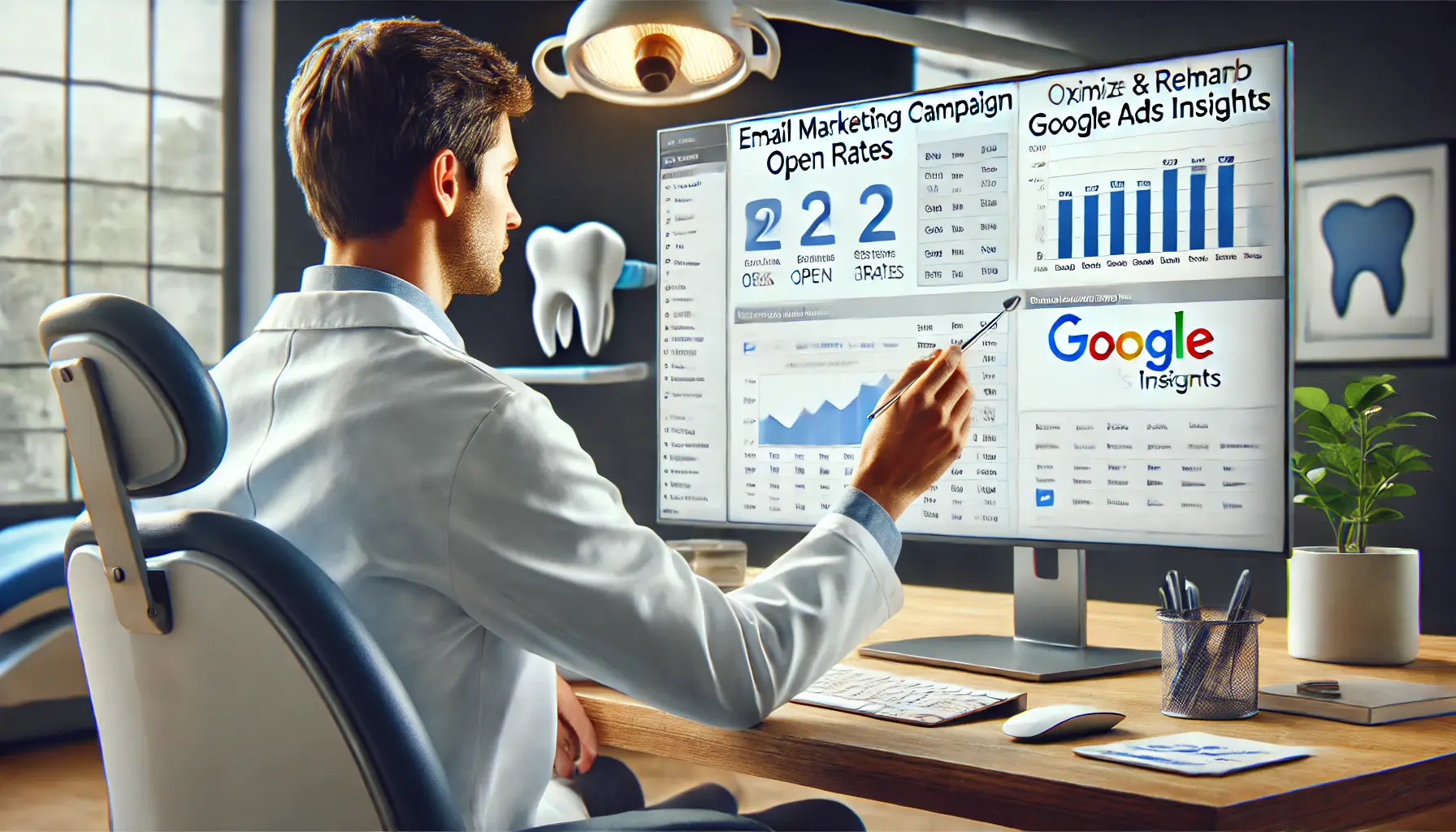
A dentist analyzing email marketing data alongside Google Ads insights to optimize campaigns.
Revamping Email Marketing Campaigns with Google Ads Insights
Email marketing remains an effective channel for retaining and engaging patients.
Combining insights from Google Ads into your email marketing campaigns allows you to:
- Segment Audiences Effectively: Use data on user behavior to tailor email content to specific patient groups.
- Personalize Content: Address individual patient needs based on their interactions with your ads and website.
- Promote Special Offers: Inform patients about promotions or new services, encouraging repeat visits.

A dentist analyzing content marketing strategies, such as blog posts and videos, alongside Google Ads metrics to enhance digital marketing efforts.
Utilizing Content Marketing to Support Google Ads Efforts
High-quality content informs patients and positions your practice as an authority.
Content marketing to support your Google Ads allows you to:
- Improve Landing Page Quality: Provide valuable information that encourages conversions.
- Boost SEO Performance: Create content that ranks organically and complements your paid efforts.
- Build Patient Trust: Share informative articles and videos that address common dental concerns.
Leveraging Google Ads in concert with these other digital marketing strategies will provide comprehensive online visibility for your dental practice to attract and retain patients, leading to continued growth and success.
Combine Google Ads with SEO, social media, and email marketing for a cohesive digital strategy that enhances patient acquisition.
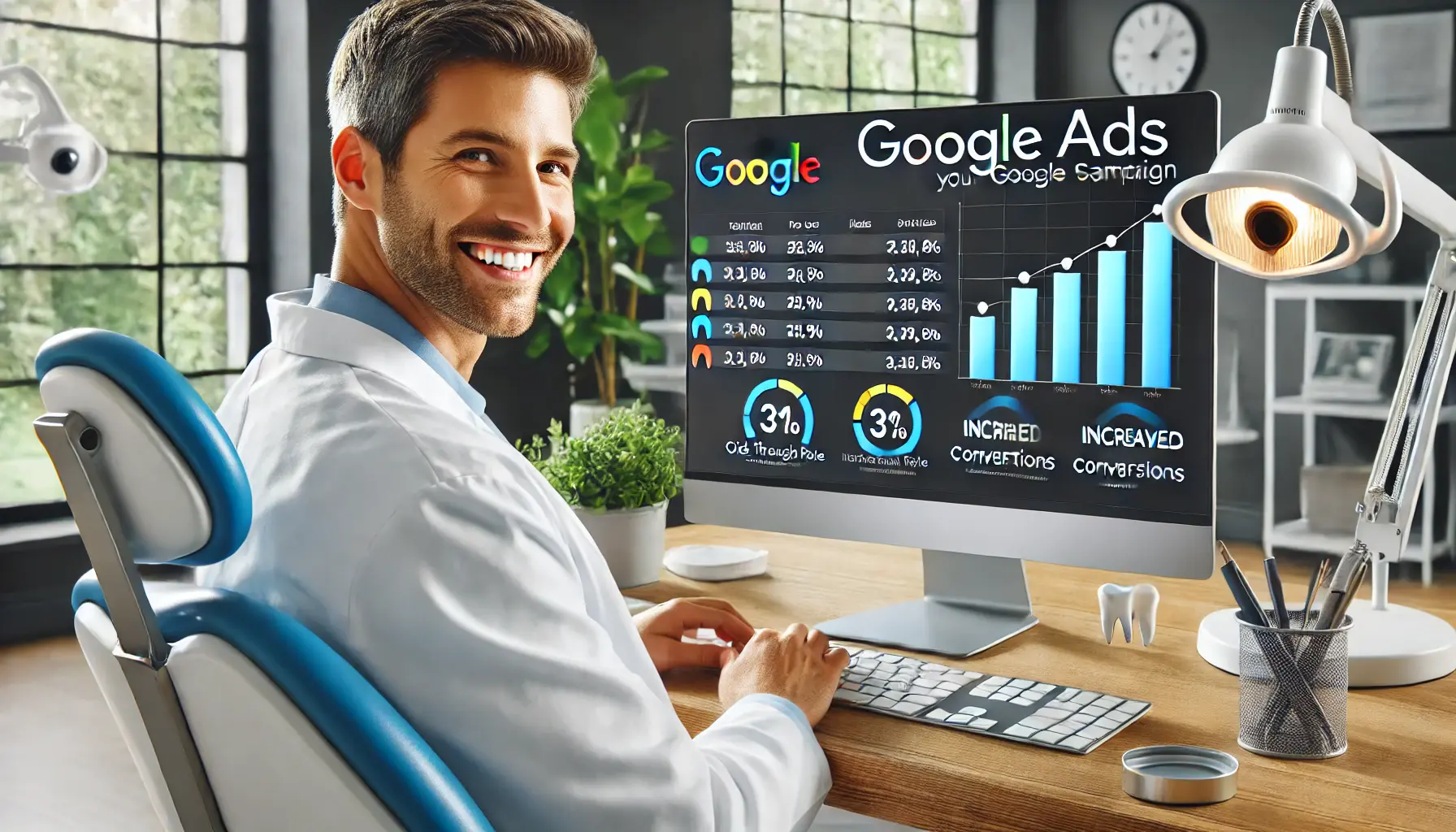
A dentist analyzing performance metrics from a successful Google Ads campaign to optimize strategy.
Maximizing Success with Google Ads for Dentists
In today’s competitive digital landscape, leveraging Google Ads for your dental practice is no longer optional—it’s a necessity.
Throughout this guide, we’ve explored how Google Ads can drive visibility, attract new patients, and complement your overall digital marketing efforts.
Let’s encapsulate the key takeaways to help your dental practice achieve optimal results.

A dentist reviewing the success of their Google Ads campaign, reflecting the essential role of digital marketing for attracting new patients.
Why Google Ads Is Essential for Dentists
Google Ads offers unparalleled precision and efficiency in targeting potential patients when they need dental services.
By investing in well-structured campaigns, your dental practice can secure a top spot in search results, ensuring that your services are visible and accessible to those actively searching for them.
This combination of immediacy and measurability makes Google Ads an indispensable tool for growth.
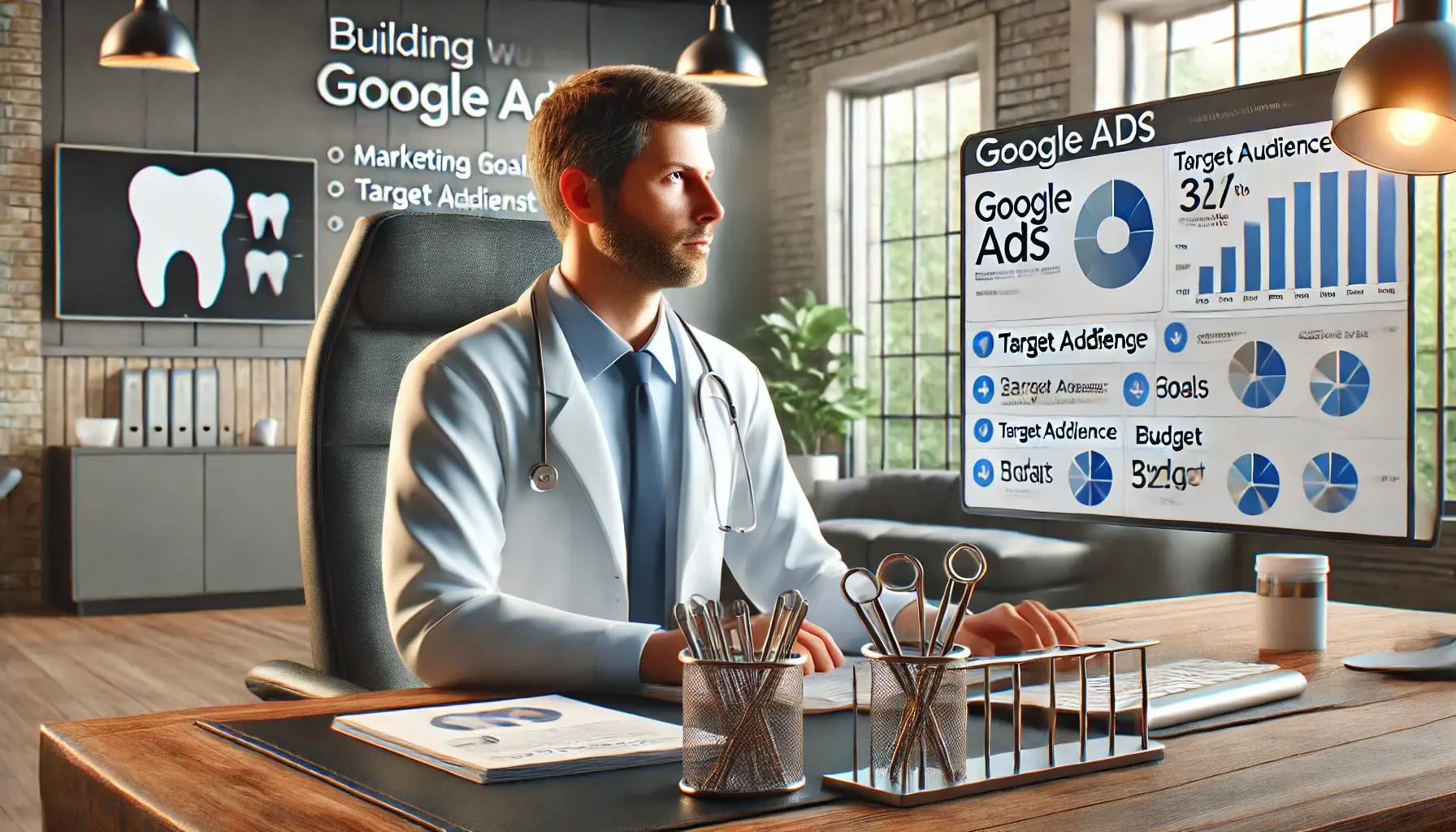
A dentist carefully planning and strategizing the next steps for a successful Google Ads campaign.
Building a Winning Strategy
Success with Google Ads starts with careful planning and execution.
Following is a summary of the key steps:
- Effective Setup: Set up your campaigns with detailed keyword research and ad copy that resonates with potential patients.
- Optimization: Ongoing refinement of your campaigns, based on key performance metrics such as CTR, CPA, and Quality Score.
- Integration: Combine Google Ads with SEO, social media, email marketing, and content marketing for a cohesive digital strategy.
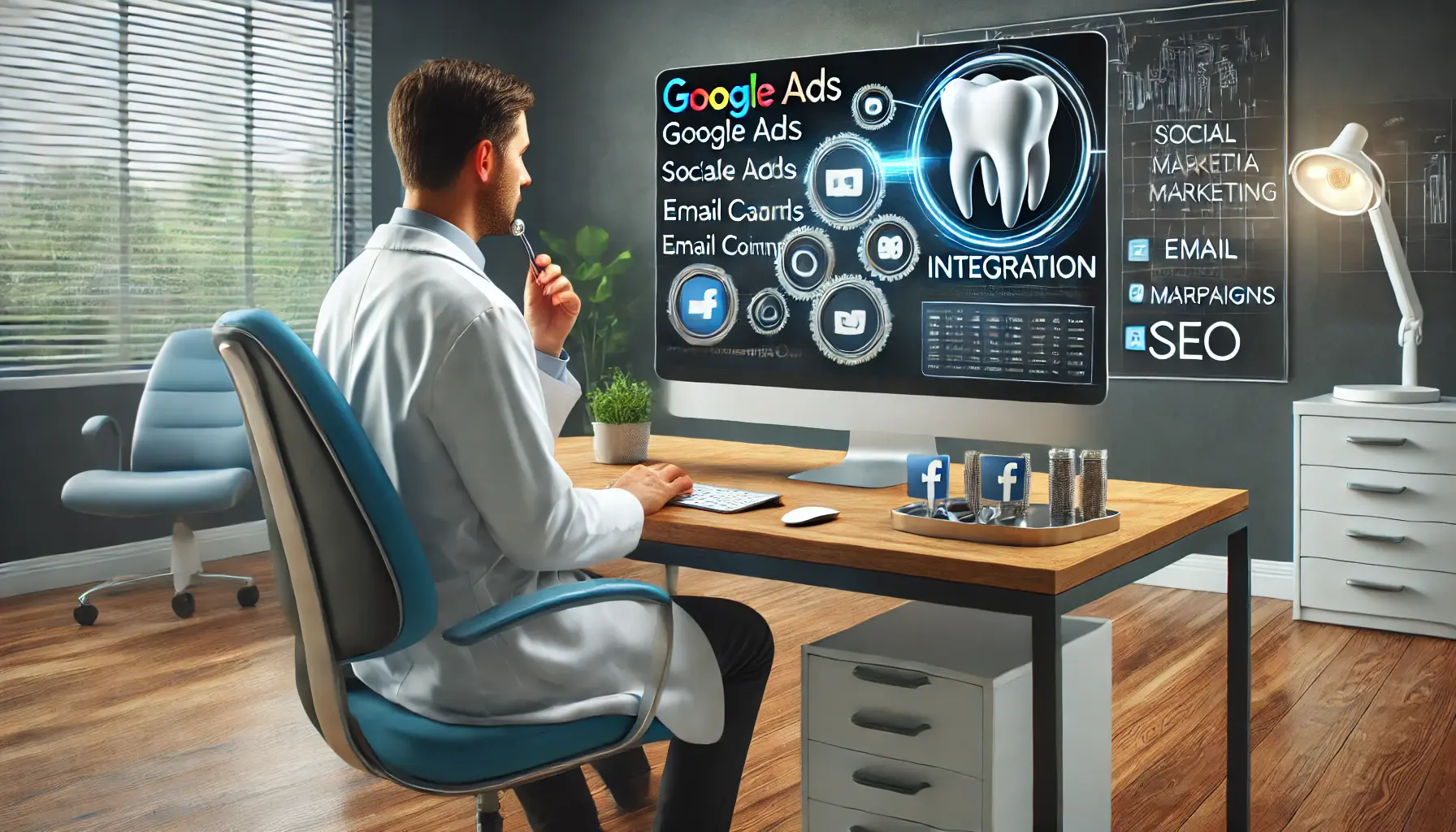
A dentist evaluating the benefits of integrating various digital marketing strategies for their practice.
The Benefits of Integration
Integrating Google Ads with other digital marketing channels amplifies your reach and impact.
Whether through retargeting on social media, personalizing email campaigns, or enhancing landing pages with quality content, this synergy creates a comprehensive approach to patient engagement.
Each channel complements the other, delivering better results than isolated efforts.

A dentist analyzing performance metrics and KPIs to measure and optimize their Google Ads campaign’s success.
Measuring and Improving Performance
Ongoing measurement is the cornerstone of a successful Google Ads strategy.
By leveraging tools like conversion tracking and Google Analytics, you can make data-driven decisions to fine-tune your campaigns.
Understanding what works and where to improve ensures that your advertising budget delivers maximum ROI.

A dentist focused on planning for long-term growth with patient acquisition and revenue increase projections.
Achieving Long-Term Growth
When done right, Google Ads doesn’t just attract new patients; it establishes your dental practice as a trusted name in the community.
With consistent efforts, you’ll not only see immediate benefits but also build a foundation for sustainable growth.
In summary, Google Ads are a game-changer for dentists.
They help dental practices reach the right audience at the right time, build trust, engagement, and loyalty.
By following the strategies featured in this guide and continuing to adapt to new trends, your dental practice will stay ahead in the digital marketing landscape and achieve long-term success.
A structured approach to setup, optimization, and integration ensures long-term growth and success through Google Ads for dental practices.
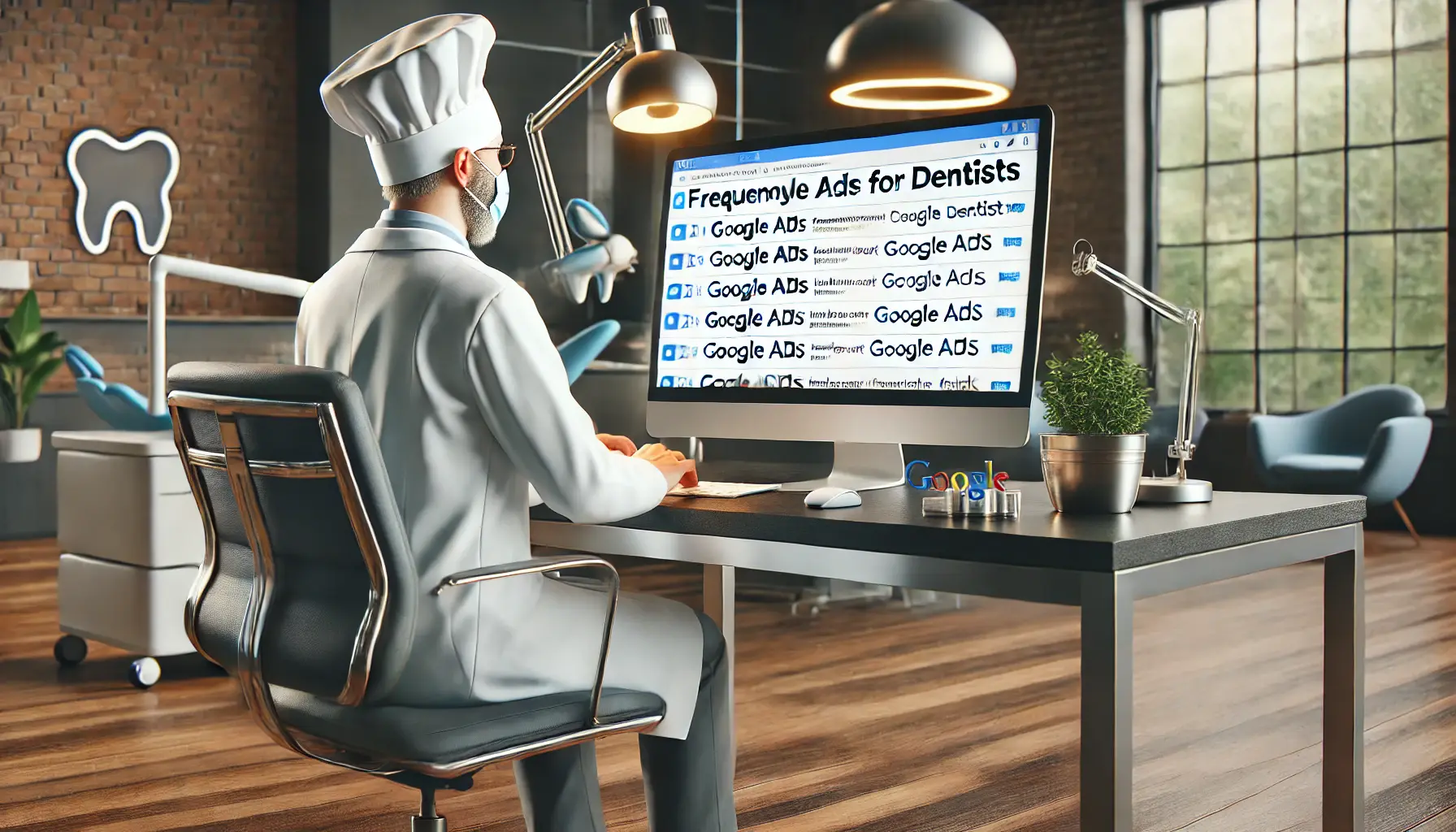
A dentist considering common questions related to Google Ads for dentists in a professional office environment.
Your campaigns can be managed by an agency specialized in Google Ads, check out our service page.
Frequently Asked Questions About Google Ads for Dentists
Addressing common inquiries can help dental practices effectively utilize Google Ads.
Below are answers to frequently asked questions.
The cost varies based on competition and targeting.
Typically, dental practices should allocate a daily budget between $10 and $100 to see effective results.
Google Ads increases online visibility, attracts potential patients actively searching for dental services, and provides measurable results to optimize marketing strategies.
Focus on specific services like ‘teeth whitening,’ ‘dental implants,’ and include local keywords such as ‘Mersin dentist’ to attract nearby patients.
Monitor key performance indicators like click-through rates, conversion rates, cost per click, and return on investment to assess campaign effectiveness.
While it’s possible to manage campaigns independently, hiring a professional can ensure optimal setup, management, and results, especially if you’re unfamiliar with the platform.
Google Ads can generate immediate visibility once the campaign is live, but continuous optimization is necessary for sustained success.
Negative keywords prevent your ads from showing up for irrelevant searches, saving budget and improving ad relevance by filtering out unwanted traffic.
Improve Quality Score by making your ad copy more relevant, your landing page more engaging, and the user experience positive to ensure a better ad position at lower costs.
Yes, Google Ads can be tailored to fit the needs and budgets of various dental practices, from small clinics to larger establishments.











